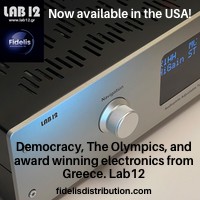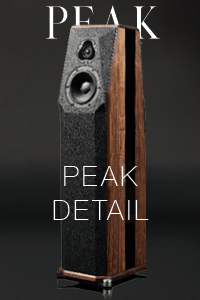 Full-line speaker manufacturers, like Focal, B&W and the brand featured in this review, often deliver the most bang for the buck in the middle of their product ranges. These products may not have the ultimate performance of the flagship, but they don’t cut corners either, as can often be the case with entry-level models. And while KEF has been garnering a lot of justified praise on its specialty speaker models, like the Blade and the LS50, the potential buyer looking for a relative audio bargain would do well to investigate the KEF R Series. There’s some fine stuff happening in this range, folks.
Full-line speaker manufacturers, like Focal, B&W and the brand featured in this review, often deliver the most bang for the buck in the middle of their product ranges. These products may not have the ultimate performance of the flagship, but they don’t cut corners either, as can often be the case with entry-level models. And while KEF has been garnering a lot of justified praise on its specialty speaker models, like the Blade and the LS50, the potential buyer looking for a relative audio bargain would do well to investigate the KEF R Series. There’s some fine stuff happening in this range, folks.
The R300 is the larger of the two bookshelf models in the R Series. And unlike its smaller sibling, the two-way R100, the R300 is a three-way bookshelf, which is not the most common of layouts for a stand-mounted speaker. It is interesting to note that the smallest speaker in KEF’s Reference Series, the 201/2, is also a three-way stand-mounted model. I’ve heard the Reference 201/2 on a number of occasions and have always been really impressed with its honest presentation of music. I’m here to tell you that the R300 gets within a stone’s throw of the 201/2, doing so at a much more reasonable price; the R300s cost $1,800 per pair, compared to $6,000 for the 201/2s.
Technology and Performance
Unlike KEF’s former middle range, the XQ Series, which were great sounding and gorgeous to boot, these R Series products won’t win any beauty contests. They are simple-looking boxes, albeit ones that are superbly finished and constructed. The review pair of R300s arrives in a nice black-gloss finish. (Rosewood and walnut veneers are also available.) The beauty of this range is in the technology and performance. Some nice touches with this line include the magnetically attached grilles and the strapless bi-wire capability, which makes for easy bi-wiring and lets you forget about losing the gold-plated brass strap usually supplied with speakers in this price category.
The R300 features yet another generation of KEF’s Uni-Q driver, which is central to most KEF products, giving them their signature coherent sound. For those unfamiliar with the Uni-Q, it is KEF’s way of making the midrange and treble drivers into a point-source radiator—the often sought-after but rarely attained ideal for a lot of speaker manufacturers. This generation Uni-Q benefits from the same technology in KEF’s flagship Blade speakers. The midrange cone is made from an aluminum-magnesium composite, which makes for much-desired lightness and stiffness. Ribs across the surface of the driver cone minimize resonance, while the surrounding material provides further dampening. The tweeter, which is made from the same material, is rear vented to reduce backward pressure, minimize distortion and increase power handling. KEF’s tangerine wave guide fits over the tweeter diaphragm to further control the already wide dispersion characteristics, particularly those at the highest frequencies.
The 6-inch bass driver is also a stiff and strong aluminum affair, anodized with a satin-like material, with a large aluminum voice coil and a vented magnet assembly behind it. One quickly realizes that this rather conventional-looking box is anything but—there is a lot of technical sophistication packed into this small cabinet.
I play music through the R300s for 80 hours before optimizing them up for serious listening, with perfect placement via a pair of 26-inch Sound Anchor stands to put the Uni-Q driver at ear level relative to the sitting position from my couch. With this placement, the front plane of the speakers is 3 feet from the back wall, with each unit 3.5 feet from the sidewalls. A slight 5-degree toe-in puts the optimum listening point with the most-stable imaging just over 9 feet from the speakers.
Serious listening begins with some small-ensemble jazz selections. First up, the self-titled Bill Frisell, Ron Carter and Paul Motian Trio, from three musicians needing no more introduction. On the album’s Miles Davis/Ron Carter bluesy composition “Eighty One,” the R300 captures the interplay of these musicians in a seemingly large acoustic space. The speakers reproduce Carter’s muscular acoustic bass without bloating, but with a tightness, depth and scale that is surprising given the small stature of the speaker. Drums appear dramatic, with a snapping snare that shows off the quick acceleration of the Uni-Q driver. Cymbals sound physically higher in the mix and have a textured shimmer with plenty of decay—this tweeter is indeed a honey. In the midst of all this, Frisell’s quirky guitar stays locked front and center, as occasional biting chords punctuate the mix. The R300 paints an engaging and natural portrait of this trio playing at the top of their game.
Next up, the Tord Gustavsen Quartet’s newest CD, The Well, on ECM; the soulful R&B composition “Circling” proves highly satisfying. The R300 puts Gustavsen’s piano squarely between the speakers in a very deep space, keeping the recording well organized amongst the rest of the players. The brushwork on drums emphasizes the low distortion of the Uni-Q driver—there is some real magic going on in this small cabinet.
I turn to vinyl for some female vocals, starting with Ella Fitzgerald’s “Black Coffee,” from the soundtrack to the 1960 film Let No Man Write My Epitaph. This sparse ballad is no more than Paul Smith on piano accompanying Fitzgerald, and brings to the forefront the precise imaging capabilities of the Uni-Q. Fitzgerald’s lead vocals are focused dead center, yet you can hear her moving around the mic during the tune, with soft piano dancing in the background all the while. This level of realism keeps me riveted to the chair for the entire album.
Patti Smith’s voice is a tough one to capture without it sounding overly harsh or shrill, and can go awry with speakers based on metal drivers, degenerating her vocals into a ball of harshness. The ease with which the R300s handle this intricate voice instantly reveals just how effectively KEF has tamed stray resonances. Howard Tate singing his 1960s hit, “Get it While You Can,” illustrates the integration of these drivers, with the rise and swell of his raspy, wide-ranging voice revealing no anomalies. Rocking out with Television’s album Marquee Moon is just good fun, yet playing this rock classic louder than is prudent demonstrates how much punishment these speakers can handle—they are much like the Blades in this respect. And it does get the juices flowing!
As with all small speakers, the R300s do a fantastic job spatially with large-scale orchestral music. They excel at delivering the timbre and tonal richness of The Reiner Sound via Classic Records’ 200-gram reissue of this Living Stereo classic. And while the fundamentals of the plucked double bass remain true to sound and texture through the R300s, there is definitely a limited reach to their low-frequency abilities. Should your musical taste require more extension, consider KEF’s R400b powered subwoofer, a perfect companion to these stand speakers. But that’s another review…
With so much attention focused on KEF’s amazing LS50, the R300 holds its own surprisingly well. It shares the LS50’s Uni-Q driver technology and to some extent its voicing, but it is a different animal indeed. The LS50 offers a slightly wider frequency response, with a smidge less midrange purity. However, it does appear to play slightly louder, so each will appeal to a different user. Think of the LS50 as a European version of the Lotus Esprit, and the R300 as its slightly heavier yet slightly more-comfortable U.S. sibling.
It should be noted that the R300’s reasonable 88-dB sensitivity means anything over about 25 watts per channel is a go—depending on your room size, of course. Tubes or solid-state power amplifiers work equally well, and the R300 is more than resolving enough to illustrate the differences. In the end, the R300 is proof positive of an exciting product from a legacy company that understands vertical integration.
KEF R300 Bookshelf Speakers
MSRP: $1,800 per pair
Peripherals
| Analog Source | VPI Classic 1/Sumiko Blackbird |
| Digital Source | Simaudio MiND streamer Rega DAC |
| Preamplifier | PrimaLuna ProLogue Premium Klyne SK5-A |
| Power Amplifier | PrimaLuna ProLogue Premium Krell KSA-50 |
















